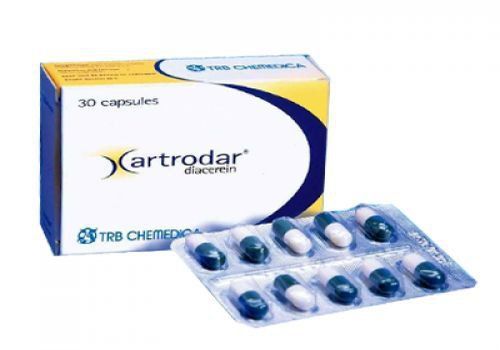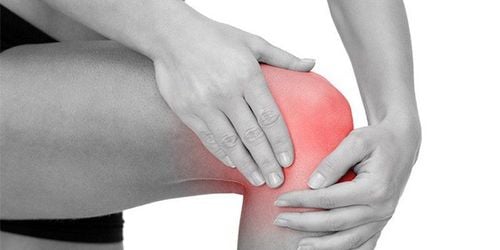This is an automatically translated article.
Cetecobeka drug has the main active ingredient Diacerein, which is effective in the symptomatic treatment of osteoarthritis. What precautions should be taken when using Cetecobeka? Let's find out information about Cetecobeka drug through the following article.1. What is Cetecobeka?
Cetecobeka drug is used in the symptomatic treatment of osteoarthritis, with the main ingredient being the active ingredient Diacerein.
Cetecobeka is made in the form of hard capsules, packed in boxes of 10 blisters x 10 tablets.
2. What are the effects of Cetecobeka?
Specific effects of the main active ingredient Diacerein contained in the drug ingredient:
2.1. Pharmacodynamics: Diacerein has anti-osteoarthritis effects, used in the treatment of degenerative joint diseases (osteoarthritis and related diseases). Diacerein has activity on chondrocyte anabolism and catabolism and reduces proinflammatory factors. In addition, studies have shown that administration of this active ingredient in several animal models of osteoarthritis consistently reduces cartilage degeneration compared with untreated groups. Diacerein significantly reduced pain and improved joint function 1 month after treatment compared with placebo (Placebo). Several studies have shown that the effects of Diacerein persist for at least 2 months after treatment has been discontinued. 2.2. Pharmacokinetics: After oral administration, Diacerein passes through the liver and is completely deacetylated to rhein. Peak plasma concentrations are reached approximately 2.5 hours after oral administration. The association with protein is very high, about 90%. This is mainly due to the strong binding affinity for albumin. The half-life of the active substance is about 4.5 hours. The total amount of drug excreted in the urine is about 30%. In patients with severe renal impairment with creatinine clearance less than 30 ml/min, the half-life was doubled and urinary excretion was halved. Cetecobeka is indicated for use in the treatment of degenerative joint diseases including osteoarthritis and related diseases.
3. How to use Cetecobeka:
3.1. How to use the drug Cetecobeka: For the drug Cetecobeka, patients use it orally. Taking the drug with meals will increase the bioavailability of the active ingredient Diacerein.
3.2. Dosage of Cetecobeka: The recommended dose of Cetecobeka for each subject is as follows:
Usual dose: 1 tablet x 2 times/day at the main meal. Long-term treatment. Treatment should be initiated at a dose of 1 tablet/day in the evening for 2 weeks because Diacerein can rapidly increase the time it takes for food to pass through the intestines during the first 2 weeks of treatment. After that, the maintenance dose is 2 tablets/day. For patients with renal impairment: Reduce to half the usual dose in patients with renal impairment with creatinine clearance less than 30ml/min. The effect of the drug is observed after 2 to 4 weeks of treatment, so it is advisable that patients do not stop treatment before the effect of the drug is not evident. Diacerein can be combined with some non-steroidal anti-inflammatory drugs or pain relievers for the first 2 to 4 weeks of treatment. 3.3. How to deal with forgetting, overdosing Missed dose:
There are currently no documents showing adverse effects when forgetting a dose of Cetecobeka. However, patients need to take the drug exactly as prescribed to achieve the most accurate effect. In case of missed dose, take the extra dose as soon as you remember. Never use a double dose at the same time.
Overdose:
If there are any adverse effects when taking an overdose of Cetecobeka, the patient should immediately notify the nearest doctor or medical facility so that timely measures can be taken.
3.4. Contraindications to Cetecobeka:
Contraindications to Cetecobeka in the following cases:
Cases where the patient is allergic, sensitive to Diacerein or any of its ingredients. The patient has a history of allergy or hypersensitivity to anthraquinone derivatives.
4. Notes when using Cetecobeka
Notes and cautions when using Cetecobeka:
For patients with renal impairment: Renal failure will change the pharmacokinetics of Diacerein, so it is necessary to reduce the dose of the drug in cases of patients with creatinine clearance less than 30ml. /minute. For children under 15 years of age: Because there are no clinical studies in children under 15 years of age, Cetecobeka should not be used in this group of people. For patients with intestinal disorders: The benefits/risks of the use of the drug should be weighed in these patients, especially irritable bowel disease. For pregnant women: This drug should not be prescribed. Lactation: It has been reported that small amounts of diacerein derivatives pass into breast milk. Therefore, it should not be prescribed to this subject. Ability to drive and use machines: There is no evidence that the use of this drug has an effect on the ability to drive and use machines. Side effects when using Cetecobeka:
When using Cetecobeka, the following undesirable effects may occur:
The most common side effect in most cases: Rapid increase in waking time bowel movements and abdominal pain. Appears in the first days of treatment with the drug. With continued treatment, the symptoms should subside. Administration of Diacerein sometimes causes dark yellow urine due to the nature of the compound contained in the drug and not clinically significant. If there are any other symptoms while using Cetecobeka, the patient should consult the treating doctor or specialist pharmacist.
Interactions, incompatibilities with Cetecobeka drugs:
Cetecobeka should not be used concurrently with laxatives. Diacerein should not be used concurrently with drugs containing aluminum, calcium and magnesium salts, oxides or hydroxides, as they may reduce the absorption of Diacerein. These drugs should be used about 2 hours after taking Cetecobeka. Storing Cetecobeka: Store the drug at the specified temperature. Keep the medicine in a cool, dry place away from moisture and avoid direct sunlight.
Above is all necessary information when using Cetecobeka medicine. Cetecobeka is a prescription drug, must be used under the direction of a treating doctor or a qualified pharmacist. Hopefully, the article has provided all the necessary notes for readers when using Cetecobeka.













